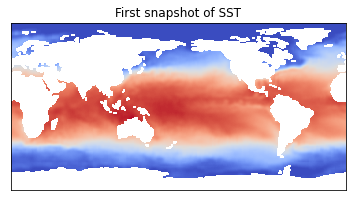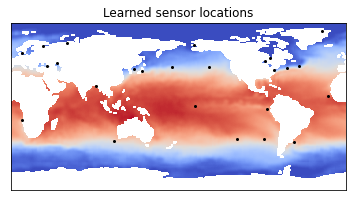Sea Surface Temperature (SST) sensors¶
This notebook demonstrates how to use PySensors to perform optimal
sensor placement for the NOAA sea surface temperature (SST) dataset.
Given a set of snapshots of the sea surface temperature as training
data, we would like to choose locations to place sensors that
collectively allow us to predict (or reconstruct) the temperature at any
other point on the ocean. We’ll show how to use the SSPOR class to
efficiently solve this problem.
See the following paper to learn about the mathematical background behind this approach:
Manohar, Krithika, et al. "Data-driven sparse sensor placement for reconstruction: Demonstrating the benefits of exploiting known patterns." IEEE Control Systems Magazine 38.3 (2018): 63-86.
Note: running this notebook requires a ~200MB file download and for
you to install the additional package netCDF4.
from ftplib import FTP
import matplotlib.pyplot as plt
import numpy as np
from sklearn import datasets
import netCDF4
import pysensors as ps
Load data¶
Import latest NOAA-SST weekly means (1990-present), published online in netCDF format
# Import and save data locally
ftp = FTP('ftp.cdc.noaa.gov')
ftp.login()
ftp.cwd('/Datasets/noaa.oisst.v2/')
filenames = ['sst.wkmean.1990-present.nc', 'lsmask.nc']
for filename in filenames:
localfile = open(filename, 'wb')
ftp.retrbinary('RETR ' + filename, localfile.write, 1024)
localfile.close()
ftp.quit();
f = netCDF4.Dataset('sst.wkmean.1990-present.nc')
lat,lon = f.variables['lat'], f.variables['lon']
SST = f.variables['sst']
sst = SST[:]
f = netCDF4.Dataset('lsmask.nc')
mask = f.variables['mask']
Plot a snapshot¶
Plot the first snapshot in the time series.
masks = np.bool_(np.squeeze(mask))
snapshot = float("nan")*np.ones((180,360))
snapshot[masks] = sst[0,masks]
plt.imshow(snapshot, cmap=plt.cm.coolwarm)
plt.xticks([])
plt.yticks([])
plt.title('First snapshot of SST')
X = sst[:,masks]
X = np.reshape(X.compressed(), X.shape) # convert masked array to array

Optimal sensor placement¶
Use a SSPOR instance to determine optimal sensor locations,
projecting the data onto 25 SVD modes. We select 25 sensors in this
example.
model = ps.SSPOR(
basis=ps.basis.SVD(n_basis_modes=25),
n_sensors=25
)
model.fit(X)
sensors = model.get_selected_sensors()
# Plot sensor locations
temp = np.transpose(0 * X[1,:])
temp[sensors] = 1
img = 0*snapshot
img[masks] = temp
plt.imshow(snapshot, cmap=plt.cm.coolwarm)
indx = np.where(img==1)
plt.scatter(indx[1], indx[0], 4, color='black')
plt.xticks([])
plt.yticks([])
plt.title('Learned sensor locations');

Note that many of the sensor locations lie along interfaces between hotter and cooler regions of the ocean.
Download python script: sea_surface_temperature.py
Download Jupyter notebook: sea_surface_temperature.ipynb